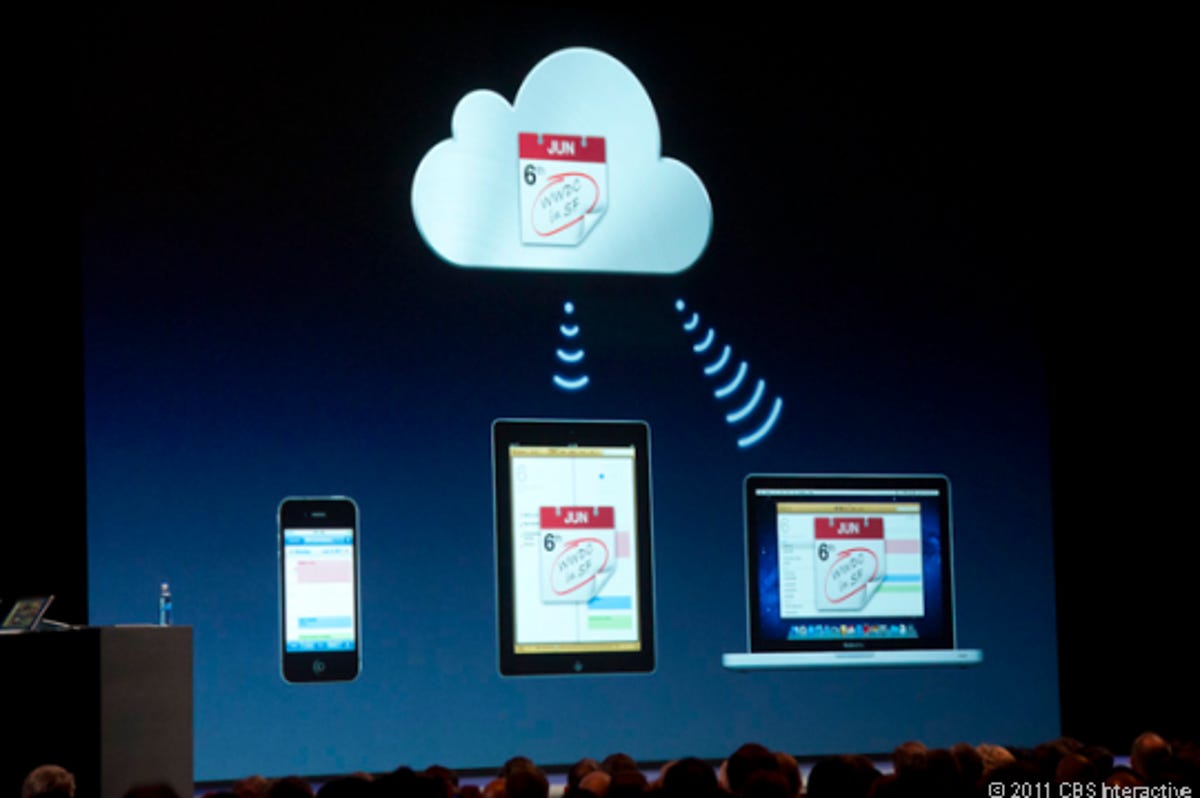
Donald Bell/CNET
Apple’s new iCloud services announced at the World Wide Developer Conference in San Francisco today will put everything from mobile apps to digital pictures to music in the “cloud,” where users can easily store and access them. But what will this mean for your wireless data bill?
Apple CEO Steve Jobs unveiled the iCloud service, which acts as a digital hub that will store and replicate content so that it can be shared among multiple iOS devices, such as iPhones, iPod Touches, and iPads.
“Now the (digital) hub is in the cloud,” Jobs said during the keynote presentation, according to CNET’s live blog. “If you get something on your iPhone, like a picture, it goes up to the cloud, and gets pushed down to the other devices automatically.”
What this means for consumers is that they’ll no longer have to connect their iOS devices to a computer to back up information or sync their music. They also won’t have to connect their devices to a computer for software updates. Their iTunes music collection, photos taken on their iOS devices, videos viewed on those devices, iBooks, e-mail, calendar information, and more will all be stored in the Apple iCloud so that users can access them on any iOS device.
Unlike other cloud-based services that may require users to manually upload music, Jobs said that Apple has automated the process to make it easy.
It all sounds great for people with iOS devices, who want access to all their content on any device. But how will all this content travel between the iPhone or iPad and the iCloud? Will this put a big strain on carrier networks, and cost consumers more money on their data plans?
Daily updates could indeed put a strain on already struggling cellular networks. But Apple seems prepared to mitigate this problem by forcing some of the data-intensive activities to be done over Wi-Fi instead of over a carrier’s cellular network.
This is especially important given that many iPhone users may not have an unlimited data plan from AT&T. Verizon Wireless, which began selling the iPhone 4 this year, has also said it plans to get rid of its unlimited data plan and move to a tiered offering.
Experts believe that with Apple’s use of Wi-Fi, plus the low-bandwidth nature of some of the updates, it shouldn’t be a problem for most consumers. For one, much of the data that will be transferred between devices will be contacts, e-mails, calendar updates, and other text-based data that doesn’t gobble up a lot of bandwidth. What’s more, when devices are synched, they’ll be updating only new information.
Secondly, software updates and major data transfers will likely be reserved for Wi-Fi only. Forrester analyst Charlie Golvin was at the WWDC event today, and he said Apple’s daily updates of iOS devices will happen over Wi-Fi only. And the bigger software updates, which will also happen automatically from time to time, will also happen over Wi-Fi and will occur only when devices are plugged in to an electrical source. This is important, because it means the software updates won’t drain the battery. Additionally, iTunes updates and syncing will also happen only over Wi-Fi.
What happens when Wi-Fi is not available? Apple didn’t mention that. And Golvin said it’s hard to say whether Apple will make it possible to do some of these more data intensive transfers over 3G, or in the future, 4G wireless networks.
Other experts speculate that Apple will give consumers a choice in the setting menu how they access the cloud-based content and backups.
“There are several ways that Apple could manage data usage,” said Ross Rubin, an analyst with NPD Group. “For example, it wouldn’t be surprising to see Apple uploading photos at a lower resolution when on a bandwidth constrained network.”
Michael Gartenberg, an analyst with Gartner, said Apple already requires that certain apps that are too large be downloaded via Wi-Fi. And he said he expects the company to give consumers some choice in how they set up their data usage.
“They may give you the option to load your pictures now or to queue them until you get to a Wi-Fi hot spot,” he said. “And you’ll likely have the option to turn off the updates.”
The new iCloud services will be available this fall. So expect Apple to discuss more details about how the service works as the launch date nears.



